#but it's bc we are FINALLY in the crux of this decade
Text


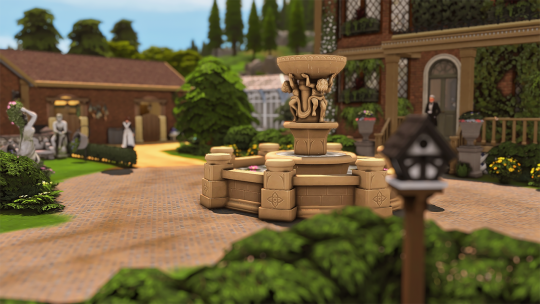


The Baudelaire family returned to Ireland the next day, only this time, they never had to worry about leaving.
Their new home had been abandoned years prior to them purchasing it and had been left vacant for quite some time after the previous family had fled those lands that had once been filled with such rich history. Overtime, the stories had been forgotten, perhaps almost purposely by those that occupied the neighborhood nowadays, existing only as children's fables or as myth.
One thing they did know though was that the land used to be a vegetable farm, quite a successful one too, and Lawrence intended to make it profitable once more. Already, the farm boys were put to work planting rows of cabbage, carrots and most notably, potatoes.
Hours of labor had gone into restoring the house to what it had once been before the family arrived and at last, it was returned to its original state of elegance. The perfectly laid brick was covered by thick ivy, and the grounds were surrounded by beautifully vibrant flowers, lush green plants, and tall, brilliant marble statues.
It all seemed like something out of a storybook rather than real life.
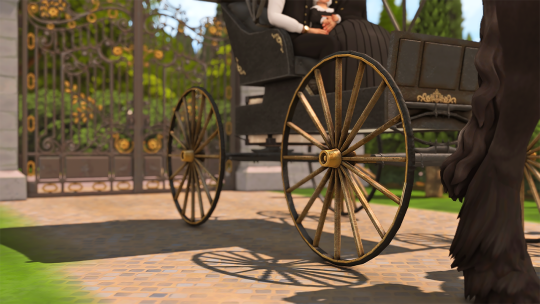

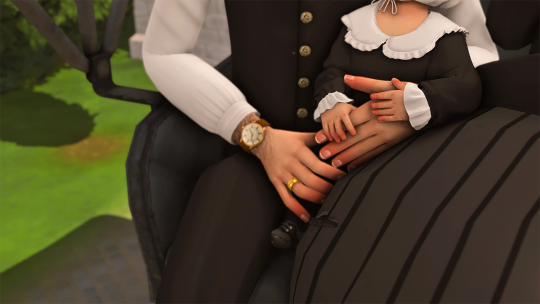
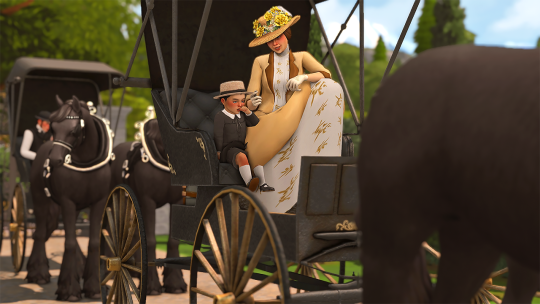
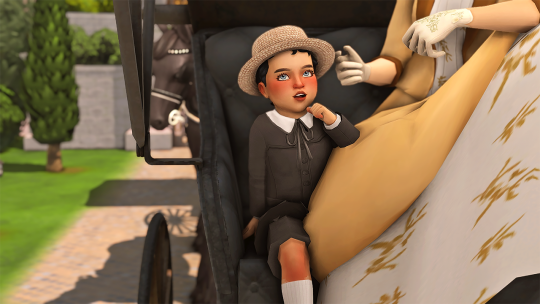
The travel horses pushed forward through the gates, and all any of them could do was gawk, unable to believe they were truly going to live here. Even the children, fussy and tired from such long travels, sensed the exhilaration from the adults and had begun to perk up with curiosity.
Ozzy, who rode with Beth in her carriage, stared up at the house in wonder, as though his little mind was trying to comprehend such a big change. "This is our new home, my little dove. We're going to live here now!" Beth whispered to the seemingly awestruck toddler next to her.
"Wooooow!" He exclaimed almost breathlessly, and though it was unclear if he actually understood what it all truly meant, Beth laughed in response, happily agreeing that 'wooow' was right.
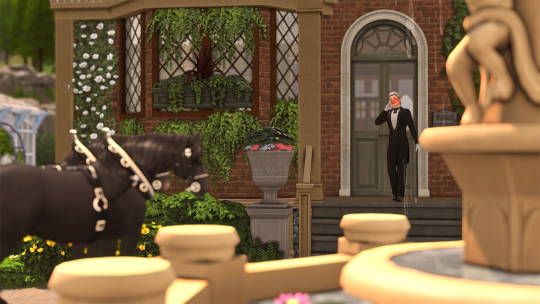



Most of their belongings arrived before The Baudelaires, already unpacked and put away thanks to a moving crew hired on by Lawrence. In addition, he had also taken it upon himself to hire various help, like maids, gardeners, cooks, and even a personal chef, and as Lawrence stepped out of the carriage and onto the stone pavement, he could see one of their footmen waiting patiently to greet them at the door.
"Well, hello there, Baudelaires!" He called out from the porch enthusiastically.
Lawrence waved a quick hello before holding out his arms to take Atticus. "That's Mr. O'Bannon. He worked for the family that lived here previously." He explained once Winifred had situated herself.
They joined Beth and Ozzy next, and walked hurriedly up the front steps while Mr. O'Bannon welcomed them home.

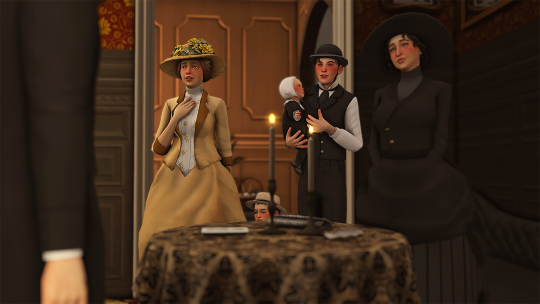



Winifred audibly gasped as she entered inside, her eyes growing wide in amazement at everything around her, and once everyone had stepped through the front door, they understood her reaction at once.
After they had filed in one by one, Mr. O'Bannon offered a tour of the house and they happily accepted. He informed them of the origins of their new furniture, boasting about the craftsmanship of the Irish workers and the prestigious color schemes of the wallpapering, most notably, the newly popular Scheels green in the parlor and the dining room.
The new decor was so complimentary of the things they had brought from home, they were almost unrecognizable sitting amongst such fine things, almost as if they were new items themselves.



They had only made it through the first two floors before Atticus started falling asleep in his mother's arms, while Ozzy began to grow rather antsy. Winifred excused herself to rock with Atticus for a while and Beth, wanting to avoid a tantrum, decided to take Ozzy outside to get a better look at the water fountain out front. Which left Lawrence to finish off the tour with Mr. O'Bannon.
However, Mr. O'Bannon dismissed himself as well, needing to check how the luncheon was coming along and confirm the table was being set correctly. Lawrence didn't mind all that much, if anything, he was relieved to see how serious his staff seemed to take their jobs.
And so, just like that, everyone was off in different directions, making themselves right at home.

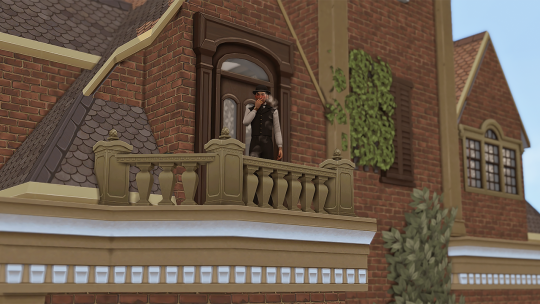


Lawrence, who now found himself alone, fancied himself a celebratory smoke out on the balcony. There, he smoked cigarette after cigarette while he watched over the farm hands below, reflecting how just months prior, he would have been down there in the dirt just like them. But, tilling soil and yanking weeds were a thing of the past, and someday soon, nothing but a distant memory.
Now, all there was left to do was assimilate to this new way of life.
next / previous / first
#foreshadowing galore here folks#posts will probably get a little shorter for a bit after this#but it's bc we are FINALLY in the crux of this decade#1893#ts4 historical#sims 4 historical#ts4 decades challenge#sims 4 decades challenge#ts4 storytelling#sims 4 storystelling#ts4 legacy#sims 4 legacy#the baudelaire legacy#1890#winifred baudelaire#lawrence baudelaire#oscar baudelaire#atticus baudelaire#beth herbert
77 notes
·
View notes
Note
I asked this question to another blog but never got an answer. I asked google but I couldn't find anything. How in God's name does me being a zutara shipper (and no I'm not sensoring the name bc why the fuck) make me a racist?
i appreciate the active hostility with which this question was asked. you seem to be really steaming right now, which makes me super inclined to answer your question with patience and respect!
by the way you phrased this, you seem to have made shipping a part of your identity. the phrasing of “a ___ shipper” vs “someone who ships ___” really speaks volumes. i’ve noticed this is the case with a lot of insular fan communities that become heavily attached to a specific romance within the show. especially when said relationship is not canon. i know it’s easy to get riled up over nothing, but i promise you this: you are not under attack. bryke did not slight you by not making your ship canon. no fan of atla is under attack for their opinions on atla. it’s a show. these are not real problems. it is perfectly valid to feel upset over the writing of a show (i, too, for example, think the mai/zuko and katara/aang resolutions in the finale were slapdash, poorly-written, and borderline-misogynistic) but at the end of the day, it’s just a show.
on the other hand, when fans of a piece of media say “hey, this phenomenon (either within the text itself, paratext, or fan engagement) with regards to this thing i like is racist, actually,” they are not just saying “i feel hurt by this fictional narrative,” but they are also saying “this is actively harmful, because even the smallest form of racism is microcosmic of a larger issue that actively gets people killed every day.” (listen. i know this is very obvious to anyone who has ever experienced racism, but i’ve encountered a lot of white people who don’t seem to grasp that racism has explicitly harmful effects, so i thought i would elucidate this matter nonetheless.)
the pairing of zuko and katara, from what i’ve witnessed of fan communities over the past decade, seems to be founded on “the inherent sexiness of antagonism.” i’ve seen people say it’s about the parallels, the yin/yang, the thematic importance of forgiveness, and sure, i’ll give you that. they do parallel each other in resonant, deliberate ways. they are fire and water. katara coming to forgive zuko represents significant growth, and their friendship is poignant and meaningful. but i fail to see how any of this is inherently romantic. it is actually possible to love someone without having sexual chemistry. i know people ship zuko with literally everyone, including twelve year olds, but for a moment let’s put our common sense hats on and assume that it would be absurd to ship him with either aang or toph. shipping him with katara seems just as absurd to me. he certainly comes to respect her a great deal, but at the end of the day, he still regards her as a child. a child whom he loves and respects, but, just like aang and toph, a child nonetheless. katara is fourteen. a grizzled war veteran, yes, but an eighth grader nonetheless. if a junior in high school started dating a fourteen year old, they would be considered a creep. you know why? because it’s creepy!
so back to what you zoot shippers seem to consider the crux of their chemistry: the antagonism. i could easily pull together eight scenes of them getting along, and yet every single gifset i’ve ever seen compiling moments of the two of them includes at least two or three in which katara still wants zuko dead. doesn’t seem very romantique to me! but what i regard as justifiable rage, a lot of you seem to think denotes sexual tension. the thing is, it’s not sexual; it’s just tension. katara has absolutely no reason to like or trust zuko, as to her, he has done absolutely nothing to prove himself distinct from the people responsible for the destruction of her home, the genocide of people like her, the murder of her mother, the spreading of an imperialist colonialist project. she trusted him to side with good in ba sing se, and nearly cost aang his life, so she knows she can’t afford to make that mistake again and risk aang dying. from her perspective, her rage is one hundred percent reasonable, and she has no plans of trusting him ever again, until he actively works to earn her forgiveness. from zuko’s perspective, he was just staring up at the sky, and now this incessant little five year old won’t stop bullying him, which is really annoying, sokka please get your irritating little sister to cut that out, why’s she being so meannnnn :(
when zuko uses katara’s necklace as leverage, that is not sexy; that is him threatening katara with a family heirloom, and all that she has left of her mother. when zuko rolls on top of her to protect her from falling rubble, that is not sexy; that is him not trusting katara is capable enough to protect herself. by the end of the episode, he realizes that she is far more powerful and capable than he ever gave her credit for, and he is awed by her power. him treating her like a child (which, frankly, is fair, because she is) is decidedly not sexy. when zuko jumps in front of lightning for katara, that is not inherently romantic; he would have jumped in front of lightning for momo, and you know it. for one thing, he wasn’t risking a single thing; he was confident that he would be able to redirect it, then azula pointed it at the wrong person, but because he is impulsive, he dove in front of it anyway because he thought he still could redirect it, even though his stance was all wrong. but when actually given a moment to think, he chose katara to fight azula with him because she was the obvious person for the job on every tactical level. she is the most powerful bender he knows. period. water extinguishes fire. and fire is at its greatest and most powerful on this day. he’s not going to let toph into the line of fire; even if suki could fight azula, it would be deeply insensitive to make her considering azula tortured her in the past; and sokka has places to be, he doesn’t have time for your sidequest! katara is obviously the person you take. and there is nothing inherently romantic about zuko’s friendship with her.
ah, but what about that time she touched his scar? was that not an unparalleled act of tenderness? a beautiful moment of gentle caress? i mean, yeah, sure, but i don’t see why that needs to be romantic. i mean, you can read romance into it, if you want to, because, like, i said, sure, but if anything, i think acting like that moment is romantic lessens its impact. this is an important moment for katara; she is humanizing the enemy! this is an important moment for zuko; he is allowing himself to be helped. i could analyze this moment for a writing standpoint endlessly, because it’s beautiful, but i won’t, because that is pointless analysis when i am, instead, trying to explain to you why i think the act of shipping this pairing is more often than not rooted in racism.
i will say this: i don’t think shipping them is inherently racist. i think if you think their friendship has potential for something more, and you think they should have gotten together, you’re not necessarily racist to think so. i think you’re wrong, but racist? well, that’s a different matter. no, i think this ship is rooted in racism for the simple fact that so much fan-generated content i’ve stumbled across over the years has been deeply, horrifically racist. i think this ship also lends itself to that kind of racism because it is so reminiscent of racist tropes that the majority white fans of the ship, either unaware of the harmful connotations of these tropes, or active fans of these tropes, love to employ uncritically. i’ve seen pocahontas aus. i’ve seen beauty and the beast aus (wherein, mind you, katara is the beast...........yes, you read that right). i’ve seen wildly popular fanart that sexualizes katara––who, may i repeat, IS FOURTEEN––in disgusting ways. and most of all, i’ve seen the delegitimization of katara’s anger towards zuko, as if she is simply supposed to “get over” the harm the fire nation has caused her. she is clearly deeply affected by the death of her mother, and zuko used her love for her mother as leverage: first, with her necklace, and second, when he used his empathy over their shared loss as a means of gaining katara’s trust. it’s clear that fans (not all, but many i’ve seen, at least those passionate enough to send me an ask with this phrasing) of this ship don’t actually give a shit about katara’s role as an indigenous woman, or why she would have no desire in dating a colonizer. sometimes it’s clear that people are actually cognizant of this, and even get off on it. they think it’s sexy. they think the racism is hot.
katara and zuko have a fascinating dynamic. they are clear foils, and their relationship is poignant and has great depth. of the little we do see of their friendship, it’s clear that they care about each other a lot. but to imply that their relationship is in any way sexual veers into racist territory really, really quickly. now, i have no idea whether you, yourself are racist. i can guess, based on your phrasing of this ask, and knowing that anyone who thinks that “being accused of racism is worse than racism” is definitely racist, but i’m not going to make any assumptions one way or another. i hope you appreciate my taking the time to answer this, because much like that other blog you sent this ask to, i have absolutely no obligation to. it shouldn’t be my role to educate people on why [x thing] is/can be harmful, especially when they are clearly asking me in bad faith and are likely to disregard everything i just wrote. so all that being said, you’re welcome.
206 notes
·
View notes
Audio

GOLGOTHA
Stay calm and await the gnashing of teeth, this is only the beginning.
4 John 1:1
Prior to crucifixion’s banishment, decreed by then Roman emperor Constantine in AD 341 as a defunct method of execution — Cicero notedly expressing the spectacle as the most cruel and hideous of them all — this practice which the Romans imported from the Phoenicians three hundred years before the fateful day above Golgotha, and which historical archives document as existent even three hundred years earlier, lent itself to a display of deterrence for law and order most manifest in the six thousand crucifixions along the Appian Way to quell Spartacus’ rebellion in 71 BC. The event, in the main, involved three stages, the victim’s flagellation, public humiliation in wrestling the patibulum of what weighed one hundred pounds to the top of a knoll, and finally the nailing of palms with iron spikes to the said crossbar and feet to the anchored staticulum, both dovetailed in a hewn mortice that was stayed by gravity’s downward force upon the suspended body. The ordeal left the persecuted prostrate with pain that for Jesus on the eve of His death the mere thought of its eventuality, inescapable as He understood it from premonitions in the Garden of Gethsemane, precipitated hematidrosis, a physiological condition of acute anxiety originating from abject fear that which induces the perspiration of blood (Luke 22:44). It was this night’s mental and physical exhaustion, a prelude to the forthcoming horrors, which compounded the agony between Gethsemane and Golgotha.
Yet Jesus’ torture was atypical of Roman crucifixion, the speed of expiry even confounding Pontius Pilate (Mark 15:44). It assuredly was the most bloodthirsty of any heretofore seen ascribed to how criminals and slaves affixed to the cross ordinarily remained conscious for several days. The Son, however, survived less than three hours when, in deference to Jewish law prohibiting crucifixions on tomorrow’s Sabbath especially amid the ongoing festivities of Passover, removal of the footrest was essential to expedite death thus entailing contortion of the feet at an extreme angle for placement of the spike into the metatarsal bones. There suspended, sardonically adorned with a crown of thorns piercing the forehead as fashioned from an acacia nilotica plant outside Jerusalem’s praetorium, this bloody deed overlooking the panorama of a sadistic mob abreast of one centurion, four legionnaires, and the exactor mortis all of whom draw lots on the inheritance of His raiment (Mark 15:17; Matthew 27:35; John 19:24), Jesus brutally suffocates from pleural effusion and finally death issues from cardiac arrest primed by hours of hypovolemic and traumatic shock. The event was a climacteric to the preceding hours beginning with Judas’ betrayal and Jesus’ apprehension who in custody was escorted to the homestead of Caiaphas, a high priest of the Sanhedrin for more than a decade and ally to the Roman emperor Tiberius. Here to the Pharisees’ displeasure the subsequent proceedings were not at all of contrition even in the wake of being seriously drubbed but rather in sheer defiance the Son in a full-throated diatribe admonishes His interrogators (Matthew 23:1-36).
The death knell that night came from one of Caiaphas’ many questions on the identity of the haggard accused now before him whose rejoinder he judged as blasphemous (Mark 14:61). ‘Are you the Messiah?’ he asked, ‘the Son of the blessed One?’ Jesus responded in the affirmative. The Nazarene fated to die was quickly marshalled to the Procurator of Judea, Pontius Pilate, and always obsequious to Rome the horde manipulated Roman law to proffer that rather than offensive to their proper religious sensibilities, in more secular logic, Jesus anointed himself king, an act they argued treasonous to Cesar (Luke 23:2; John 19:12; John 19:15). Incredulous of the false charge, Pilate sought to recuse himself and court favour of an enemy hence he next despatched Jesus to Herod (Luke 23:12), tetrarch of Tiberias there in Jerusalem already to fete Passover. The legal rationale was that inasmuch as His ministry originated in Galilee only the magistrate whose jurisdiction includes the province should adjudicate the case. Yet Herod, too obtuse for the moment’s significance, solicited instead for entertainment of cute parlour tricks and some wizardry from the Galilean (Luke 23:8). These overtures Jesus spurned who, then clothed patronizingly in the garb of a king, was returned to Pilate. Intransigent still, however, the Roman Prefect continued to balk at the petition electing instead to have the Son scourged and not executed in a show of appeasement that he trusted the restive mob would accept.
Such flagellation materialized more gruesomely than what popular conception allows or what the Church seems to have sanitized as tantamount to casual whipping. Miniature size pieces of sharp metal and bone were stitched into the many tails of the flagrum whereby each of the thirty-nine welts, on account of Mosaic Law proscribing anything above, inflicted an array of gaping wounds upon the flesh of the naked victim whose hands were chained to a column fully exposing the dorsum as he first doubled then kneeled when racked with pain that radiated all throughout his body. This method did the Romans habitually avail themselves of to prosecute verdicts of capital punishment in executions of Gentiles. Shrill screams resonated, ribs fractured, pneumothorax resulted in the collapse and bruising of lungs, muscles hemorrhaged all from the alternating blows between the flogging predators each of whose fresh opportunity at this schadenfreude obstructed the victim’s ability to breath as the oedema of pleural and pericardial fluid accumulated in the chest cavity and that the effluence of blood and water from Jesus’ impalement later bespoke (John 19:34). The harrowing experience caused dehydration associated with excessive perspiration and in preceding the Crucifixion there ensued the onset of hypovolemic shock. The Shroud of Turin ultimately numbers lacerations in excess of one hundred thus it is widely accepted the flagrum consisted of three thongs to inflict one-hundred-and-seventeen lashes commensurate with the thirty-nine prescribed by Mosaic Law.
Jesus long resigned to His fate, offering no mea culpa of recantation, stood for the last time before Pilate who once already endeavoured to exculpate the Nazarene by way of a Paschal Pardon which the Jews outrightly jettisoned in supplicating instead for the release of the murder Barabbas (Matthew 27:15; Luke 23:18; John 18:39). Presently bleeding crimson from orifices all over the body, Pilate hopes clemency for the prisoner’s appearance would quiet further cries for punishment, the obstreperous crowd did not acquiesce, neither dispersing nor yielding in size and unrest. Fear now beleaguers the Prefect. From his chair with trappings of Roman authority and of prosecutorial discretion a message was borne to him from his wife beset with worry, ‘Have nothing to do with that righteous man’, it read, ‘for I have suffered much because of him today in a dream’ (Mathew 27:19). Pilate in a fit of conscience once more attempted to set free the grossly disfigured Nazarene yet the cacophony of anger grew ever more deafening, ‘If you release this man, you are not Caesar’s friend; for everyone who makes himself king sets himself against Caesar’ (John 19:12). ‘Shall I crucify your King?’ Pilate now perched atop Gabbatha bellowed to the mass of skeptics below (John 19:13). ‘We have no king but Caesar’, they reciprocated (John 19:15), so it was the lot of Jesus was irrevocably sealed.
From the praetorium to Gologtha, the place of condemnation and execution, a half-mile of road was trudged upon at noon by the parade of Jesus who balanced the instrument of His death atop a bloodstained shoulder (John 19:14). Of the four crosses that Romans customarily used, crux immissa (t), crux commissa (T), crux decussata (x), and crux simplex (I), the configuration of the first in this case is certain which Luke the Apostle corroborates in his recording of the Titulus Crucis placed ‘over him’ (Luke 23:38). So enfeebled was the Son by midday, exhausted, dehydrated, bloodied, and symptomatic with siriasis that the exactor mortis commanded an onlooker, Simon of Cyrene, to carry the crossbeam for the remainder of the journey lest the prisoner die on route. By this time Jesus’ vestiture adhered to His body, and, akin to a bandage torn from a lesion, the fabric that papered over His open wounds which it clotted was abruptly divested upon arrival at the hilltop with agonizing hurt. Forensic pathologists concur at this point around the brutality mimicked onto the Shroud of Turin that Jesus most certainly suffered a collapsed and hemorrhagic lung prior to the Crucifixion as his body could only sustain less than three hours more of torture. What followed proved exponentially more sinister than the beating and flagellation combined in the prologue of evil about to be visited upon Him.
Atop Golgotha Jesus’ cloak and tunic were shed. Cast to the ground on His back amid sweltering heat, the executioners stretch the arms to align directly above the crossbeam. Twelve-inch nails driven into the radial sides of both palms then strike the median nerves to a paroxysm of incredible pain derived from causalgia. The crossbeam and body are hoisted to the mortice beneath the apex of the stipe, a shallow angle then bends the knees, and finally the contorted feet are disposed to suffer the same fate as the hands only this time exacted upon the plantar nerves which elicits an identical response. No more than a brief moment passes before cramping of the calves and thighs exacerbate the trauma attributed to injuries already sustained from the haemorrhaging lung, broken thoracic cage, and lacerations to the dorsum. The sleepless night in the Garden of Gethsemane has markedly lowered the pain threshold and is punctuated by the ubiquity of shock, together with this phenomenon does lactic acid in the muscles prompt hyperventilation, and the attendant pleural effusion further truncates breath. It is the advent of a new sensation inspired from the inflammation of nerves throughout the arched body which begins to intensify: Jesus is now on fire. Spectators cheer and jeer at the Nazarene who claims to be Christ, and the high elevation of the cross amplifies the acoustics of their piercing laughter to its vertex where He languishes in silence, about this time the skies above have darkened to a sullen hue (Matthew 27:45).
The Son hangs listlessly from the cross, the skin symptomatic of shock turns ashen, spittle and vomitus regurgitated at intervals saturate the body as a result of nausea precipitated by critically low levels of blood volume and pressure. A hematologist would argue at least a fifth of it has hemorrhaged by this time. The acidic content of sweat trickling down from the perforated forehead by the crown of thorns stings those abrasions inflicted from, before the march to the crest of this hill, repeated strikes of a staff upon the head (Mark 15:19). Amid the orgasm of bloodlust, the soldiers who spat on Jesus’ visage and ridiculed Him moments ago rest with grinning faces, the crowd in turn expresses its enthusiasm at the sanguinary sight. ‘He deserves to die’ (Mathew 26:66), they yell, whistle, and beam with euphoria. At this hour, poor circulation to the heart begins the irreversible reaction of organ failure, moreover keen pains still accompany every breath from the uncharacteristic brutality of the scourging from the previous morning. Much of Jesus’ plasma pools in regions of the lungs, tremors and seizures assail the body, and faint with thirst a sponge of water is raised to His lips of which He drinks in one draught. Jesus, ever pugnacious, His wretched body an icon of the malice sown in the hearts of men, knew Father’s will had finally been done. Looking up at Him with stoic eyes right before death, here on a hill christened Golgotha humanity’s most powerful words were spoken: ‘It is finished’. The Son dies at three in the afternoon, year thirty-three anno Domini, on the third day of April.
1 note
·
View note